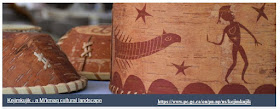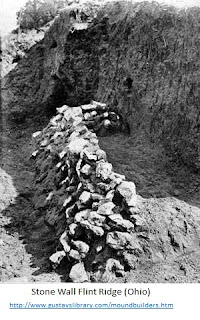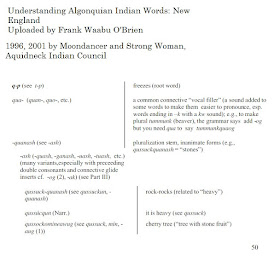Multiple Layers of Meaning in the Mi'kmaw Serpent Dance –
Trudy Sable
“How far back this
dance goes among the Mi'kmaq is difficult to say. Possibly it originated from
the Ohio Valley where the serpent mounds of the Adena tradition are found:
interchange between the Ohio Valley and the Maritimes 3,000 years ago is
documented (Ruth Whitehead, personal communication, 1996).”
“First, as seen in the language, the world is experienced
and expressed as fluid, in a constant flux, or as a process, not static and
objectified. For instance, there are a number of words for Creator, e.g. kisu
Ikw, ankwey-ulkwjikeyulkw, tekweyulk, most of which are transitive verbs
describing different processes of creation that do not begin or end, but are
ongoing. The word adapted by the missionaries to communicate the abstract
concept of 'God' is Niskamij, which is both a kin term and an honorific term meaning
'grandfather', 'step-father', and 'father-in-law' (Francis, personal
communications, 1995-96).
Second, because of the fluid nature of reality, everything
in the culture seems to accommodate and adjust to a world of shifting
realities. Many of the legends are filled with shape-shifting and unpredictable
beings with whom one had to interact appropriately to survive. The nature of
the language, stories, songs and dances, all seem to be a way to re-create and
re-evaluate reality again and again, and to re-establish one's relationship
within it continuously. Third, everything expresses a world of relationships,
or things in association or in relation with other things, not existing as
separate entities. This can be seen in the language in the extension of kinship
terms to things, animals and other-than-human-beings, as well as in the social
organization. Similarly, the terms for colours illustrate this relational
quality. Except for the four colours red, black, white and yellow (also the
colours used for the four directions), all colours are associative — or
"analogized", as Francis (personal communications, 1995-96) terms it.
Even these four, however, are thought to have derived from Proto-Algonquian
words that associate them with blood (red), light/sunlight/dawn (yellow and
white), and ash (black) (Whitehead 1982:71). Other colour terms mean like the
sky' (blue), 'like the fir trees' (forest green), etc. Thus there is no way to
describe the colour of blue and green rocks, or even a dream of blue and green
rocks, without ascribing to them a connection, or relation, to the sky and fir
trees. Furthermore, all colours — including black, red, yellow and white — are
intransitive verbs that can be conjugated. The translation of maqtewe 'k
(black) is 'in the process of being black', inferring that there is no fixed
state of blackness, but rather a stage in a process that could change (Francis,
personal communication, 1996). Fourth, many levels of meaning can be compressed
into one word, one utterance, one step — a whole image that might take many
sentences in English to write out can be expressed in one word or one movement,
similar to mnemonic marks made to convey information, or wampum belts with each
bead associated with some message. As well, there may be implicit meanings that
are not conveyed in the literal translation of a word but simply come from
being part of the culture...
...The word jujijuajik, according to Margaret Johnson, means
'acting like a snake'. She explained that the word jujij refers to things that
crawl on the ground, e.g. snakes, lizards and spiders. This is in keeping with
Hagar who quotes Silas T. Rand, the 19th-century Baptist minister to the
Mi'kmaq, as defining jujij as a general term for 'reptile'. Hagar also mentions
that, despite this definition, several Mi'kmaq assured him it designated the
rattlesnake (Hagar 1895:37). John Hewson defined jujij as 'serpent' and
jujijuajik as 'they do the serpent', but Francis was uncertain that this was an
accurate definition. Nicholas Smith cites Jack Solaman, a Maliseet from Tobique
Point, as using the word al-la-de-gee-eh in a singing of the "Snake Song"
in 1915. This word was translated by Peter Paul as 'moves like a snake', though
it does not actually contain the word 'snake' in it; rather, it literally means
"it has the motion of a snake" (Smith n.d.).
In the Mi'kmaw language,
this would be alatejiey, which is translated as 'crawling around, or the
movement that the snake makes' (Francis, personal communication, 1996). This
translation seems similar to Margaret Johnson's definition of jujijuajik. The
actual word for 'snake' in Mi'kmaq is mteskm (Hewson, personal communication,
1996)...
...The Jipijka 'm is a powerful symbol in Mi'kmaw legends.
It lives and travels beneath the earth or water, and its horns, one red and one
yellow, were used for personal power particularly by puoinaq, or what are
referred to as shamans today. It can also take on human form and live as a
human in the underwater world. The red and yellow horns of the jipijka 'm are
power objects, and stories about the use of jipijka 'm horns are known all the
way across northern North America and across the centuries, back to northern
Asia (Whitehead, personal communication, 1996)...
Hagar describes it as "a horned dragon,
sometimes no larger than a worm, sometimes larger than the largest serpent...
He inhabits lakes, and is still sometimes seen" (Hagar 1896:170)...
In summary, the Serpent Dance involves many layers of
meaning and embodies a richness of information and profundity. First, this one
dance brings together a web or system of relationships that occur
simultaneously — the changing of seasons, most probably linked to the
appearance or position of a constellation in the sky, connected in turn to the
time of the moulting of snakes, which were indicators for the ripening and
picking of medicine.
On another level, the Jipijka 'm was the essence or
protector of medicine, which was the spirit ally of the puoin, who was the most
powerful shaman. Ultimately, the dance protected the well-being of the people
themselves. Second, the mirroring of one thing in another is evident — the
microcosm reflecting the macrocosm. The dance itself mirrored the sound of the
plant, the coiling and uncoiling of both the literal snake awakening from
hibernation and shedding its skin, and the essence of the medicine in the form
of the Jipijka'm, and possibly the constellation in the sky and the changing or
"turning over" of seasons. The plant, meteteskewey, may have mirrored
the Jipijka 'm in its appearance and sound, if the identification of the plant
is correct.
Possibly, as well, the constellation in the sky mirrored the cycle
of the snake on earth, like the constellation Ursa Major mirroring the
hibernation, birth, and hunt of the bear as it moves through the sky in the
winter and spring (see Hoffman 1954:253). Furthermore the male and female
dancers were possibly a reflection of male and fevna\e jipijka 'maq, as well as
the male and female plants. Finally, the dance illustrates the Mi'kmaw
relationship to the world as being part of universal processes and cycles, of
"tuning in" to the fundamental energy and rhythms and reflecting and
expressing those processes and rhythms in the dance. The dance was a means to
help effect the changing or turning over of seasons, and channel the energy
appropriately so that the medicine would be powerful and effective, just as
other aspects of nature — temperature, soil composition, weather patterns, etc.
-contribute to the process. Dance was a way to reflect and come to know the
world, embody and communicate its rhythms and its stories, and re-establish
one's relationship to and within a shifting reality again and again.”


































